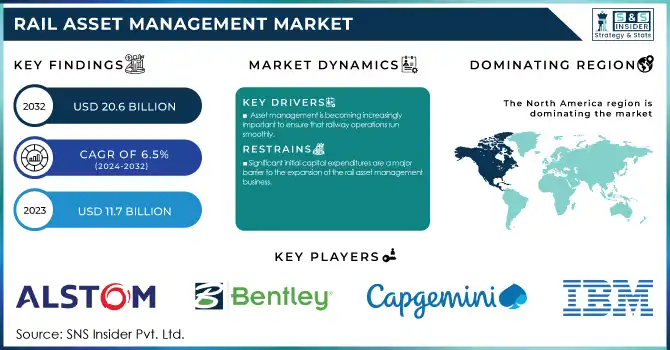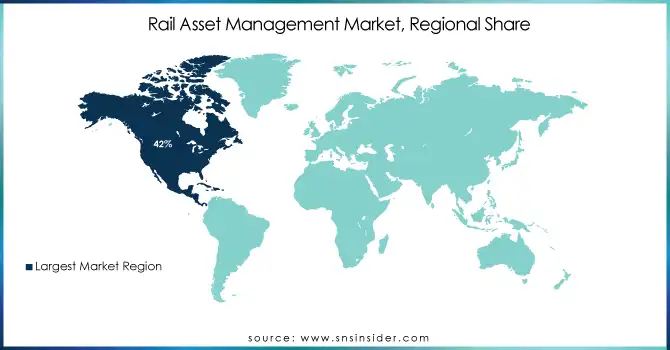Rail Asset Management Market Report Scope & Overview:
The Rail Asset Management Market Size was valued at USD 11.7 Billion in 2023. It is expected to grow to USD 20.6 Billion by 2032 and grow at a CAGR of 6.5% over the forecast period of 2024-2032.

To Get More Information on Rail Asset Management Market - Request Sample Report
High demand for smart rail solutions will bring a change in the rail sector due to which many asset management systems with better functionalities will be introduced. Utilizing the power of the Internet of Things, Artificial Intelligence, and big data analysis these solutions enable businesses to track assets in real-time, conduct condition-based monitoring, automate inspection, and more. Smart rail solutions allow for continuous monitoring and predictive maintenance which reduces operational costs and downtime, improving overall efficiency. In addition, it's very vital to safely identify faults before they become a major one. Increasing the data and digitalization in railways is becoming an important trend to cope up with growing transportation demand and reliability.
According to a report from the International Union of Railways (UIC), global investment in railway infrastructure reached approximately USD 275 billion in 2022, with governments and private sectors significantly contributing to this. This investment aims to modernize rail systems and expand networks, reinforcing the critical role of effective asset management solutions in enhancing connectivity and operational efficiency.
The rapid acceptance of digitization and the Internet of Things (IoT) for optimization, an increase in public-private partnerships and government efforts, and hyper-urbanization and population growth all necessitate the development of transportation networks. The complex technologies used by railway and metro systems entail a wide range of human operators, companies, and technology solutions. Computerized systems with intelligence are a practical way to manage such complexity. The term "Industry 4.0" refers to the concept of the fourth industrial revolution, distinguished by the presence of intelligent systems and solutions that rely on the Industrial Internet. This revolutionary era encompasses integrating advanced technologies into various industries, leading to enhanced productivity, efficiency, and connectivity. Railways in particular have embraced Industry 4.0 to a significant extent in the transportation sector.
In 2023 KfW IPEX-Bank played a crucial role as the Mandated Lead Arranger in facilitating the acquisition of Rail First Asset Management (Rail First), a prominent Australian rollingstock leasing company. This significant achievement was made possible through a collaborative effort between Amber Infrastructure Group, DIF Capital Partners, and an esteemed international banking consortium. Rail First proudly possesses the country's third-largest intermodal fleet, boasting an impressive collection of 1,300 locomotives and wagons.
Rail Asset Management Market Dynamics
Drivers
-
Asset management is becoming increasingly important to ensure that railway operations run smoothly.
-
Rapid adoption of advanced technologies and digitization
-
Higher demand for cloud-based solutions drives the market growth.
One of the major drivers for the growth of cloud-based solutions and services is that they can bring down both IT costs and management complexity. Cloud-based rail ERP platforms provide scalable, flexible, and cost-effective alternatives to traditional on-premises systems that are increasingly capable of delivering operational efficiencies and data management across an enterprise. Such solutions provide the ability to access data through real-time connections, even while on the move, enabling stakeholders the opportunity to track asset performance, maintenance schedules, and resource management from remote locations; allowing quicker decision-making and responsiveness.
In addition, cloud solutions can be integrated easily with other systems such as IoT devices and big data analytics tools, helping improve predictive maintenance and operational insights. This integration is key to maximizing asset performance, increasing the lifecycle of assets, and driving down operational costs. It also allows teams to seamlessly collaborate, communicate, and coordinate with each other an essential feature in the complex world of rail.
Also, several organizations realize the importance of digital transformation, which confirms that the scale of cloud computing is increasing. International Data Corporation (IDC) research states that global spending on cloud services reached USD 500 billion in 2023 which proves that this is a strong trend and encourages moving to various other sectors as well such as rail. So, the increasing demand for cloud-based solutions is solving the current challenge faced by rail operators and enabling an evolution toward modernization and technology.
Restraint
-
Significant initial capital expenditures are a major barrier to the expansion of the rail asset management business.
High upfront capital cost is a major entry barrier for the growth of the rail asset management market. However, this usually requires a large investment up front for things such as software development costs and the purchase of hardware required to integrate with existing technologies. In regions where budgets are constrained or funding is limited, rail operators face challenges in finding the required resources for such investments therefore delaying innovation. Furthermore, there is the inherent complexity of integrating all these systems with legacy infrastructure, which can drive costs up and make implementation more complicated. These costs may create a disproportionate barrier to entry for smaller operators, or make upgrading asset management capabilities a lower priority compared to other projects for larger operators.
Opportunity
-
Increasing government spending on train infrastructure and digital projects
Rail Asset Management Market Segmentation Overview
By Deployment
The cloud segment held the largest market share of around 68% in 2023. This can be attributed to its scalability and flexibility. By utilizing cloud solutions, railway companies can avoid expenses associated with hardware, software, storage, and technical personnel. Cloud-based platforms also offer a unified approach through SaaS-based security services, ensuring the protection of business applications. These platforms are particularly advantageous for organizations facing budget constraints when it comes to investments. The railway industry is witnessing a surge in the adoption of cloud deployment mode, primarily due to the ease of maintenance and upgrades provided by cloud-based asset management solutions.
By Application
Rolling Stock held the largest market share around 60% in 2023. It is owing to the importance of rolling stock in a rail-oriented operation. Rolling stock consists of vehicles that move on a railway, which could be passenger cars, locomotives, or freight wagons. Even more importantly, effective management of these assets is vital for the operational efficiency safety, and reliability of rail services. In an era where fleet optimization is gaining new heights, rail operators are turning to intelligent asset management solutions that allow them to perform real-time monitoring and predictive maintenance, with performance analytics capabilities. Such capabilities assist in prolonging the lifespan of rolling stock, eliminating downtimes, and cutting down on operational expenditure.
Rail Asset Management Market Regional Analysis
North America held the largest market share around 42% in 2023. Due to the quick implementation of big data and IoT in railway operations and management. Railroads are a crucial link in the supply chain for transporting both intermodal containers and bulk goods. The interconnected network of linked devices enables real-time monitoring and tracking as well as data collection, storage, and processing, producing useful analytics discoveries and actionable insights. One application of IoT in the transportation industry, notably rail, is telematics. Telematics-based tools support the tracking of a vehicle's location and activities, the detection of engine issues, and the gathering of other crucial performance information.
The Asia Pacific region is expected to experience the highest growth rate, primarily driven by the increasing adoption of new technologies, substantial investments in digital transformation, and the rising GDP of nations in the region. One notable example of Asian megaprojects is the ambitious Don Mueang-Suvarnabhumi-U-Tapao railways in Thailand, with a staggering budget of USD 7.3 billion. This project aims to construct a high-speed rail route spanning 221 kilometers, connecting various key locations. Moreover, the Asian Development Bank plans to assist governments, such as Azerbaijan, in establishing safe, easily accessible, and environmentally friendly transportation systems by 2022. To support this initiative, the Austrian government has contributed a substantial amount of $595,654, leveraging its expertise to help Azerbaijan strengthen its railway transportation system. By enhancing transportation infrastructure and embracing technological advancements, the Asia Pacific region is poised to capitalize on its potential for growth.

Do You Need any Customization Research on Rail Asset Management Market - Enquire Now
Key Players in Rail Asset Management Market
-
IBM (IBM Maximo)
-
Capgemini (Railway Asset Management Solutions)
-
Bentley Systems (OpenRail)
-
Alstom (HealthHub)
-
Huawei (Rail Cloud)
-
Hitachi (Hitachi Rail Asset Management)
-
Wabtec (Advanced Train Control System)
-
Siemens (Railigent)
-
Cisco (Cisco Connected Rail)
-
Accenture (Intelligent Rail Asset Management)
-
SAP (SAP Asset Management)
-
Uptake (Uptake Asset Management Platform)
-
Machines with Vision (MV2 Rail Inspection System)
-
Trimble (Trimble Rail Solutions)
-
Atkins (Rail Asset Management Services)
-
Trapeze Group (Trapeze Operations Management)
-
Tego (Tego Asset Management)
-
KONUX (KONUX AI-based Asset Management)
-
ZEDAS (ZEDAS Rail Asset Management)
-
Cyient (Cyient Rail Solutions)
Key User
-
BNSF Railway
-
Union Pacific Railroad
-
CSX Transportation
-
Norfolk Southern Railway
-
Canadian National Railway (CN)
-
Deutsche Bahn AG
-
SNCF (Société Nationale des Chemins de fer Français)
-
Transport for London (TfL)
-
London Underground
Recent Development:
-
In 2023 Capgemini launched a new suite of Railway Asset Management Solutions aimed at improving operational efficiency and decision-making through advanced data analytics and cloud computing.
-
In 2023, IBM announced the expansion of its Maximo Asset Management platform, integrating AI and IoT capabilities to enhance predictive maintenance and asset performance for rail operators.
-
In 2023, Alstom unveiled HealthHub, a new data-driven asset management solution designed to monitor the health of rolling stock in real-time, enhancing maintenance strategies and reducing operational costs.
| Report Attributes | Details |
| Market Size in 2023 | US$ 11.2 Bn |
| Market Size by 2032 | US$ 18.65 Bn |
| CAGR | CAGR of 5.83 % From 2024 to 2032 |
| Base Year | 2023 |
| Forecast Period | 2024-2032 |
| Historical Data | 2020-2022 |
| Report Scope & Coverage | Market Size, Segments Analysis, Competitive Landscape, Regional Analysis, DROC & SWOT Analysis, Forecast Outlook |
| Key Segments | • By Offering (Solutions, Services) • By Deployment Mode (Cloud, On-premises) • By Application (Rolling Stock, Infrastructure) |
| Regional Analysis/Coverage | North America (US, Canada, Mexico), Europe (Eastern Europe [Poland, Romania, Hungary, Turkey, Rest of Eastern Europe] Western Europe [Germany, France, UK, Italy, Spain, Netherlands, Switzerland, Austria, Rest of Western Europe]), Asia Pacific (China, India, Japan, South Korea, Vietnam, Singapore, Australia, Rest of Asia Pacific), Middle East & Africa (Middle East [UAE, Egypt, Saudi Arabia, Qatar, Rest of Middle East], Africa [Nigeria, South Africa, Rest of Africa], Latin America (Brazil, Argentina, Colombia Rest of Latin America) |
| Company Profiles | IBM, Capgemini, Bentley Systems, Alstom, Huawei, Hitachi, Wabtec, Siemens, Cisco, Accenture, SAP, Uptake, Machines with Vision, Trimble, Atkins, Trapeze Group, Tego, KONUX, ZEDAS, Cyient, Assetic, Delphisonic, WSP, OXplus, L&T Technology Services |
| Key Drivers | • Asset management is becoming increasingly important to ensure that railway operations run smoothly. • Rapid adoption of cutting-edge technologies and digitization • Higher demand for cloud-based solutions |
| Market Restraints | • Significant initial capital expenditures are a major barrier to the expansion of the rail asset management business. |

